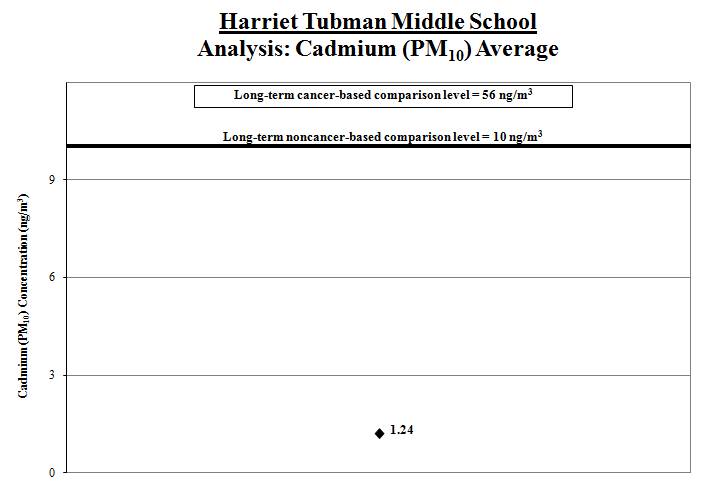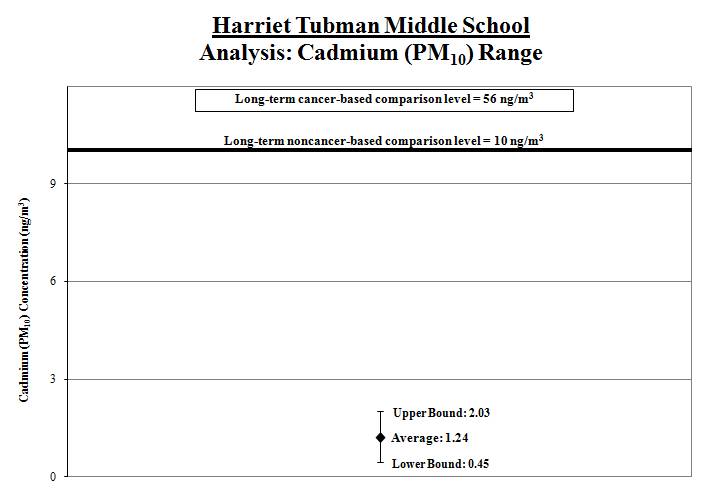Assessing Outdoor Air Near Schools
Harriet Tubman Middle School - Portland, OR
- Understanding the Monitoring Data
- Initial Sample Results
- Initial Analysis
- Additional Sample Results
- Final Analysis
Results and Analysis of EPA’s Additional Monitoring
EPA selected this school for monitoring because it is located near a mix of industrial sources and several interstate and state highways which are sources of air toxics emissions. Air monitoring was initially conducted at Harriet Tubman Middle School from August 23, 2009, to November 3, 2009, to assess concentrations of acrolein, benzene, 1,3-butadiene, and other volatile organic compounds (VOCs); manganese, nickel, and other metals in particulate matter less than 10 microns (PM10); and acetaldehyde and other carbonyl compounds in the air. Although measurements of the key pollutants were below levels of significant concern that had been suggested by modeling information prior to monitoring, EPA extended air toxics monitoring at Harriet Tubman Middle School because measurements of cadmium (PM10) indicated an issue of potential concern. This information from the 2009 monitoring is provided in the first report (PDF) (44pp, 944k). Additional monitoring for cadmium and other metals was conducted at Harriet Tubman Middle School from May 27, 2011 to July 17, 2011.
Primary Findings |
The levels of cadmium measured in the outdoor air over this two-month period continue to indicate the influence of nearby sources. The concentrations of this pollutant and the associated longer-term concentration estimates do not indicate the potential for the mixture of pollutants in the air to pose concerns for long-term continuous exposures. |
Key Pollutant Monitored |
Cadmium. Inhalation of cadmium at high levels can affect the kidney and cause cancer. |
Next Steps |
Based on the analysis described here, EPA will not extend air toxics monitoring at this location. EPA remains concerned about emissions from sources of air toxics and continues to work to reduce those emissions across the country, through national rules and by providing information and suggestions to assist with reductions in local areas. The ODEQ will continue to oversee industrial facilities in the area through air permits and other programs. The ODEQ will also continue to implement reductions in mobile sources through implementation of national programs and its own programs. |
Approach:
- A monitor collected air samples from May 27, 2011 through July 17, 2011 at Harriet Tubman Middle School in Portland, Oregon.
- Individual air sample results are posted on this website.
- When the monitoring was complete, we analyzed the results to see if there was a concern from long-term concentrations (over a lifetime).
- Also, when the monitoring was complete, we evaluated all the air samples from the on-site monitor. We also evaluated information on wind speed and wind direction from a weather monitor at the school, along with historical weather information and information about nearby sources of cadmium emissions.
Findings:
- Measured values of cadmium (PM10) and other monitored pollutants indicate an influence of sources at this school.
- The process to identify schools for monitoring relied on emissions estimates and other information. Ambient air monitoring at the school allowed measurement of what was actually in the air.
- The nearby sources influencing the air quality at the school have not been identified by ODEQ.
- Based on these findings, EPA will not extend air toxics monitoring at the Harriet Tubman Middle School.
- Click here for additional information
The analysis considered whether the information collected at these schools might raise concerns for the health of children or adults at these schools. We looked at the following types of information:
- Measured cadmiumconcentrations and information on cadmium
- Measured wind direction and wind speed at this school
- Information about nearby sources of cadmium emissions
Analysis of Measured Concentrations:
At Harriet Tubman Middle School, cadmium (PM10) and other monitored pollutants indicate an influence of sources at this school. The complete analyses of these data do not indicate levels of concern for long-term, continuous exposure to cadmium individually, and to the mixture of these pollutants in areas of this neighborhood.
1. Calculate the cadmium average: We calculated the averages of the cadmium measurements (shown by the black diamond in the graph below). We compared these averages to the long-term comparison levels (see thick line on the graph below).
Result: The average cadmium levels for the samples collected at Harriet Tubman Middle School were below the long-term comparison levels.

2. Calculate a range for the cadmium average: To account for varying air concentrations of cadmium, we calculated ranges around the averages. We did this by estimating high and low values that the longer-term concentrations might reach using common statistical tools. We compared the highest points in the ranges (called the “upper bounds”) to the long-term comparison levels.
Result: The high ends of the ranges for the samples collected at Harriet Tubman Middle School are lower than the comparison levels.

Analysis of Measured Wind Direction and Wind Speed at Each School
We took measurements of wind direction and speed every day during the sample period. We took special note of the wind speed and direction on the days we took measurements of cadmium.
| What we looked at | What we found |
We looked at whether the wind data taken on the days we took measurements of cadmium are similar or different from the wind patterns during the entire sampling period. |
We found the wind patterns taken on the days we took measurements of cadmium to be generally similar to those observed during the entire sampling period. |
We looked at whether the wind pattern during the sampling period is reflective of regional wind pattern over the long term. |
The wind pattern at the monitoring station at Harriet Tubman Middle School during the sampling period is somewhat similar to the historical long-term wind flow pattern at that same school. This suggests that, on a regional scale, the 2-month sampling period may be somewhat representative of year-round wind patterns. |
Analysis of Information on Nearby Sources of Cadmium Emissions
| What we looked at | What we found |
Whether we could determine if the sources were operating as usual during the sampling period. |
The nearby sources influencing the air quality at the school have not been identified by ODEQ. |
The concentrations of the key pollutants plus others, and the associated longer-term concentration estimates do not indicate the potential for the mixture of pollutants in the air to pose concerns for long-term continuous exposures. |
Additional Information
- Technical Report for School: Assessing Outdoor Air Near Schools: Additional Monitoring at Harriet Tubman Middle School (Portland, OR) (PDF) (23pp, 545k). The technical report is a follow-up to the original monitoring which took place. The report is geared toward risk assessors, risk managers, and other regulatory agencies.
- Background on School Monitoring Effort
- General Questions and Answers for School Monitoring Effort
